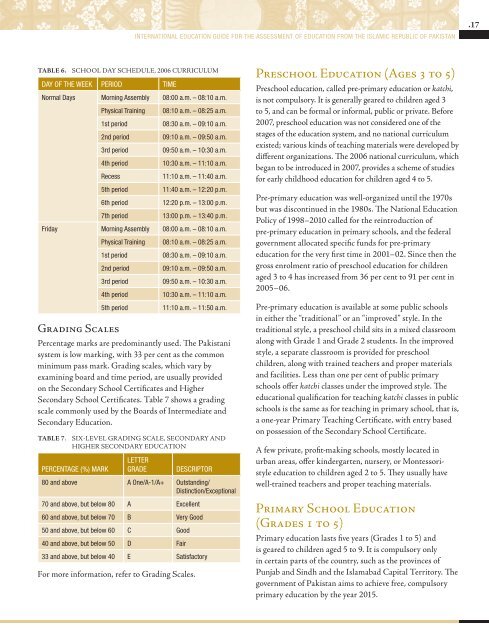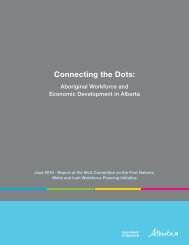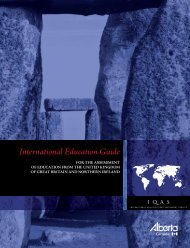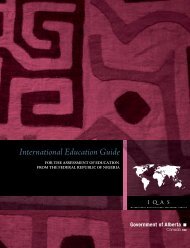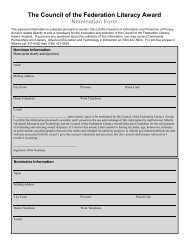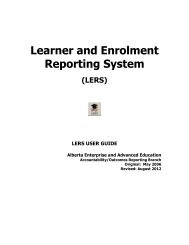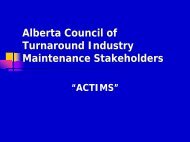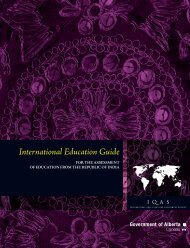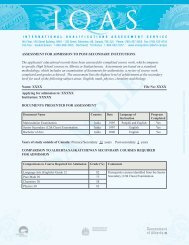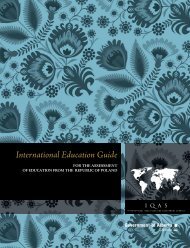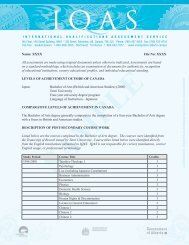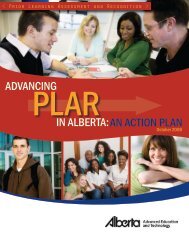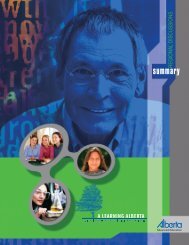International Education Guide - Enterprise and Advanced Education ...
International Education Guide - Enterprise and Advanced Education ...
International Education Guide - Enterprise and Advanced Education ...
You also want an ePaper? Increase the reach of your titles
YUMPU automatically turns print PDFs into web optimized ePapers that Google loves.
INTERNATIONAL EDUCATION GUIDE for the assessment of education from the Islamic Republic of Pakistan<br />
.17<br />
Table 6. School Day Schedule, 2006 Curriculum<br />
Day of the Week Period Time<br />
Normal Days Morning Assembly 08:00 a.m. – 08:10 a.m.<br />
Physical Training<br />
1st period<br />
2nd period<br />
3rd period<br />
4th period<br />
Recess<br />
5th period<br />
6th period<br />
7th period<br />
08:10 a.m. – 08:25 a.m.<br />
08:30 a.m. – 09:10 a.m.<br />
09:10 a.m. – 09:50 a.m.<br />
09:50 a.m. – 10:30 a.m.<br />
10:30 a.m. – 11:10 a.m.<br />
11:10 a.m. – 11:40 a.m.<br />
11:40 a.m. – 12:20 p.m.<br />
12:20 p.m. – 13:00 p.m.<br />
13:00 p.m. – 13:40 p.m.<br />
Friday Morning Assembly 08:00 a.m. – 08:10 a.m.<br />
Physical Training<br />
1st period<br />
2nd period<br />
3rd period<br />
4th period<br />
5th period<br />
Grading Scales<br />
08:10 a.m. – 08:25 a.m.<br />
08:30 a.m. – 09:10 a.m.<br />
09:10 a.m. – 09:50 a.m.<br />
09:50 a.m. – 10:30 a.m.<br />
10:30 a.m. – 11:10 a.m.<br />
11:10 a.m. – 11:50 a.m.<br />
Percentage marks are predominantly used. The Pakistani<br />
system is low marking, with 33 per cent as the common<br />
minimum pass mark. Grading scales, which vary by<br />
examining board <strong>and</strong> time period, are usually provided<br />
on the Secondary School Certificates <strong>and</strong> Higher<br />
Secondary School Certificates. Table 7 shows a grading<br />
scale commonly used by the Boards of Intermediate <strong>and</strong><br />
Secondary <strong>Education</strong>.<br />
Table 7.<br />
Six-Level Grading Scale, Secondary <strong>and</strong><br />
Higher Secondary <strong>Education</strong><br />
Percentage (%) Mark<br />
Letter<br />
Grade<br />
Descriptor<br />
80 <strong>and</strong> above A One/A-1/A+ Outst<strong>and</strong>ing/<br />
Distinction/Exceptional<br />
70 <strong>and</strong> above, but below 80 A Excellent<br />
60 <strong>and</strong> above, but below 70 B Very Good<br />
50 <strong>and</strong> above, but below 60 C Good<br />
40 <strong>and</strong> above, but below 50 D Fair<br />
33 <strong>and</strong> above, but below 40 E Satisfactory<br />
For more information, refer to Grading Scales.<br />
Preschool <strong>Education</strong> (Ages 3 to 5)<br />
Preschool education, called pre-primary education or katchi,<br />
is not compulsory. It is generally geared to children aged 3<br />
to 5, <strong>and</strong> can be formal or informal, public or private. Before<br />
2007, preschool education was not considered one of the<br />
stages of the education system, <strong>and</strong> no national curriculum<br />
existed; various kinds of teaching materials were developed by<br />
different organizations. The 2006 national curriculum, which<br />
began to be introduced in 2007, provides a scheme of studies<br />
for early childhood education for children aged 4 to 5.<br />
Pre-primary education was well-organized until the 1970s<br />
but was discontinued in the 1980s. The National <strong>Education</strong><br />
Policy of 1998–2010 called for the reintroduction of<br />
pre-primary education in primary schools, <strong>and</strong> the federal<br />
government allocated specific funds for pre-primary<br />
education for the very first time in 2001–02. Since then the<br />
gross enrolment ratio of preschool education for children<br />
aged 3 to 4 has increased from 36 per cent to 91 per cent in<br />
2005–06.<br />
Pre-primary education is available at some public schools<br />
in either the “traditional” or an “improved” style. In the<br />
traditional style, a preschool child sits in a mixed classroom<br />
along with Grade 1 <strong>and</strong> Grade 2 students. In the improved<br />
style, a separate classroom is provided for preschool<br />
children, along with trained teachers <strong>and</strong> proper materials<br />
<strong>and</strong> facilities. Less than one per cent of public primary<br />
schools offer katchi classes under the improved style. The<br />
educational qualification for teaching katchi classes in public<br />
schools is the same as for teaching in primary school, that is,<br />
a one-year Primary Teaching Certificate, with entry based<br />
on possession of the Secondary School Certificate.<br />
A few private, profit-making schools, mostly located in<br />
urban areas, offer kindergarten, nursery, or Montessoristyle<br />
education to children aged 2 to 5. They usually have<br />
well-trained teachers <strong>and</strong> proper teaching materials.<br />
Primary School <strong>Education</strong><br />
(Grades 1 to 5)<br />
Primary education lasts five years (Grades 1 to 5) <strong>and</strong><br />
is geared to children aged 5 to 9. It is compulsory only<br />
in certain parts of the country, such as the provinces of<br />
Punjab <strong>and</strong> Sindh <strong>and</strong> the Islamabad Capital Territory. The<br />
government of Pakistan aims to achieve free, compulsory<br />
primary education by the year 2015.


